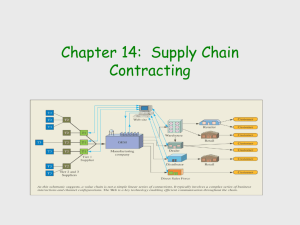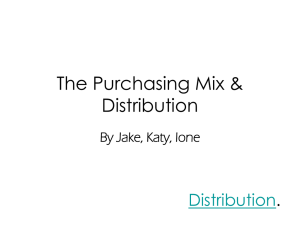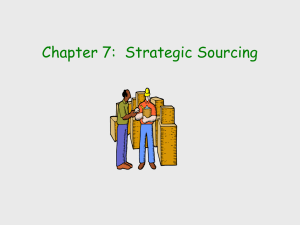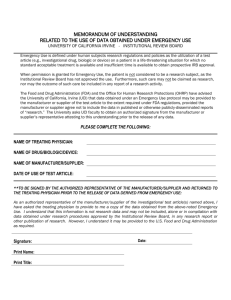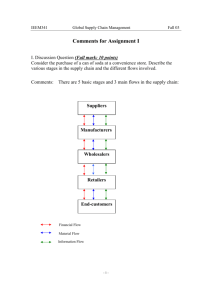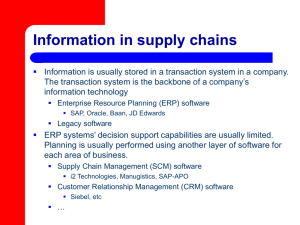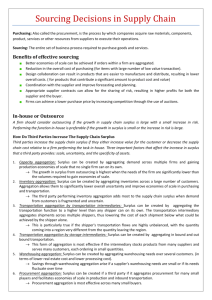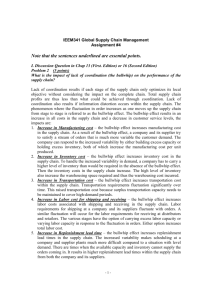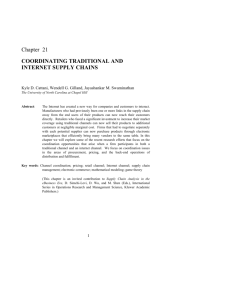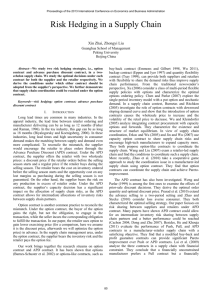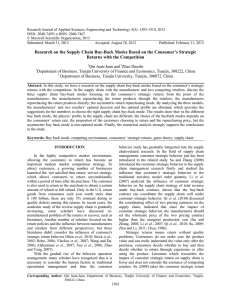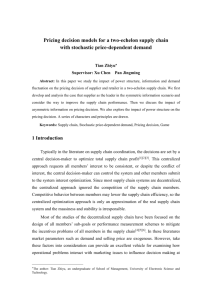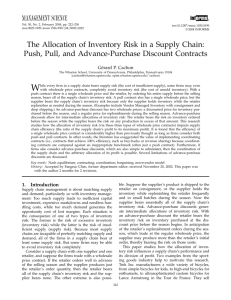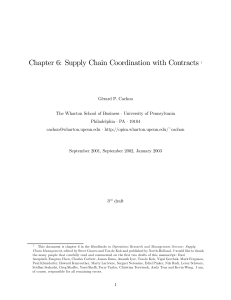Chapter 14 discussion questions
advertisement
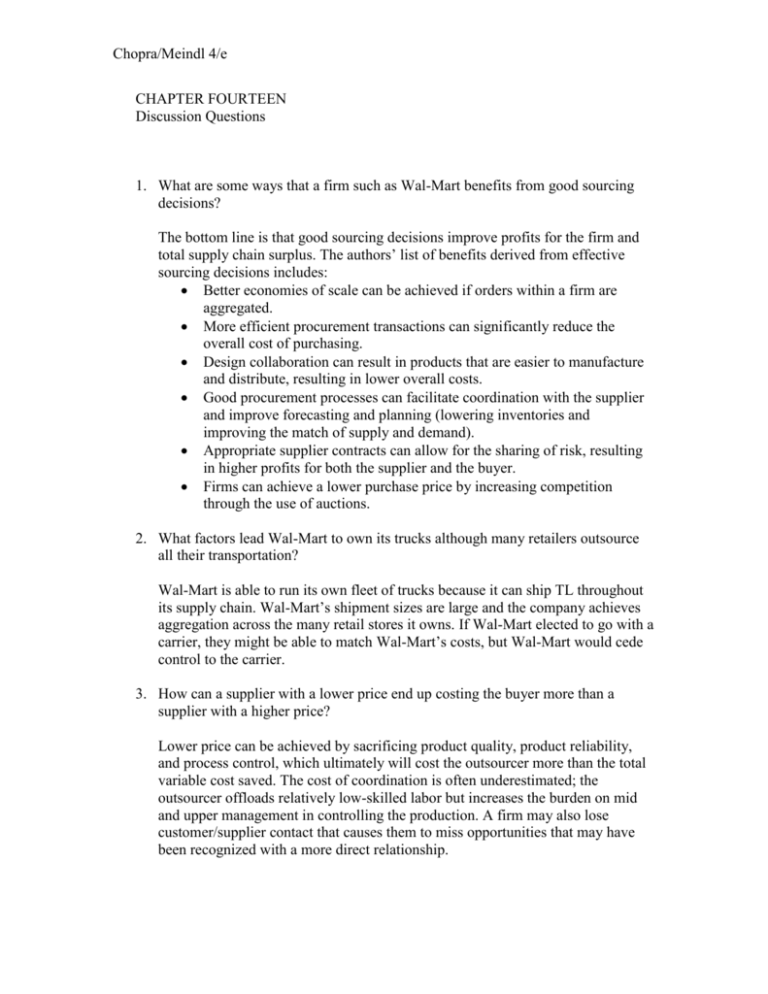
Chopra/Meindl 4/e CHAPTER FOURTEEN Discussion Questions 1. What are some ways that a firm such as Wal-Mart benefits from good sourcing decisions? The bottom line is that good sourcing decisions improve profits for the firm and total supply chain surplus. The authors’ list of benefits derived from effective sourcing decisions includes: Better economies of scale can be achieved if orders within a firm are aggregated. More efficient procurement transactions can significantly reduce the overall cost of purchasing. Design collaboration can result in products that are easier to manufacture and distribute, resulting in lower overall costs. Good procurement processes can facilitate coordination with the supplier and improve forecasting and planning (lowering inventories and improving the match of supply and demand). Appropriate supplier contracts can allow for the sharing of risk, resulting in higher profits for both the supplier and the buyer. Firms can achieve a lower purchase price by increasing competition through the use of auctions. 2. What factors lead Wal-Mart to own its trucks although many retailers outsource all their transportation? Wal-Mart is able to run its own fleet of trucks because it can ship TL throughout its supply chain. Wal-Mart’s shipment sizes are large and the company achieves aggregation across the many retail stores it owns. If Wal-Mart elected to go with a carrier, they might be able to match Wal-Mart’s costs, but Wal-Mart would cede control to the carrier. 3. How can a supplier with a lower price end up costing the buyer more than a supplier with a higher price? Lower price can be achieved by sacrificing product quality, product reliability, and process control, which ultimately will cost the outsourcer more than the total variable cost saved. The cost of coordination is often underestimated; the outsourcer offloads relatively low-skilled labor but increases the burden on mid and upper management in controlling the production. A firm may also lose customer/supplier contact that causes them to miss opportunities that may have been recognized with a more direct relationship. Chopra/Meindl 4/e 4. Explain why, for the same inventory level, a revenue-sharing contract results in lower sales effort from the retailer than if the retailer has paid for the product and is responsible for all remaining inventory. The retailer puts forth a lower sales effort because they are paid less on a per unit basis to sell items under a revenue sharing contract than under a buyback or a classic retail contract. The manufacturer and retailer agree to share a fraction of the retailer’s revenue after agreeing on a low wholesale price. The low wholesale price triggers a larger order from the retailer, and this can increase supply chain surplus if all product is sold. What happens in practice is that the retailer has a smaller upside under the revenue sharing arrangement and loses the incentive to push merchandise. 5. For a manufacturer that sells to many retailers, why does a quantity flexibility contract result in less information distortion than a buy-back contract? A buy-back contract allows a retailer to return unsold inventory to the supplier; the contract will stipulate the maximum amount returnable and the reimbursement amount the retailer will receive. A buy-back contract provides an incentive for the retailer to place a larger order and make product more available and can increase total supply chain surplus. A downside of buy-back contracts is information distortion, i.e., the supply chain is aware of the retailers’ orders and not the actual customer demand until the sales period has ended. This problem is exacerbated by a situation involving multiple retailers each of which holds inventory. A quantity flexibility contract permits the retailer to change the quantity ordered after observing demand; the contracts are similar to buy-back contracts except no returns are required. With a quantity flexibility contract, retailers specify only the range within which they will purchase, well before actual demand arises. The supplier can aggregate inventory across all retailers and build a lower level of surplus inventory. Since retailers order closer to the point of sale when demand is more visible and less uncertain; the uncertainty is aggregated by a supplier that enjoys lower information distortion. 6. Most firms offer their sales force monetary incentives based on exceeding a specified target. What are some pros and cons of this approach? How would you modify these contracts to rectify some of the problems? Two incentive oriented contracts discussed in the chapter are the two-part tariff and the threshold contract. The two-part tariff increases sales agent effort by allowing the retailer to acquire product at cost and letting the dealer’s margin be the supply chain margin. Threshold contracts establish greater rewards for the retailer as total sales reach successively higher brackets. These incentives can increase supply chain profits but can also be gamed to maximize retailer/agent bonuses without benefiting the manufacturer. Sales can be postponed from one sales period to the next by slow-playing customers, post-dating paperwork, and minimizing efforts. The sales that would have occurred in period 1 are delayed to Chopra/Meindl 4/e period 2, during which sales efforts are maximized; for the same level of sales, the agent has an increased commission, but the manufacturer realizes a lower profit. This gamesmanship also causes information distortion at the producer. These problems can be avoided by modifying the contracts with a rolling horizon. Rather than creating a high bonus period over a fixed period of time, reduced bonuses can be offered continuously over a shorter time period. The rolling periods have many “last weeks” built in and lead to a more constant level of effort from the retail sites. 7. An auto manufacturer sources both office supplies and subsystems such as seats. What, if any, difference in sourcing strategy would you recommend for the two types of products? For an auto manufacturer, seats are considered direct materials (components used to make finished goods) while office supplies are indirect materials (goods used to support the operation of a firm). The procurement process for direct materials should be designed to ensure that components are available in the right place, in the right quantity, and at the right time. Sources should be carefully selected to ensure that quality and responsiveness are acceptable and that a long-term relationship is possible. The primary goal of the procurement process should be to make production plans and current levels of component inventory at the manufacturer visible to the supplier and should have alerts built into it if mismatches between supply and demand are detected. The procurement process for indirect materials should be on reducing the transaction cost of each order. These items are not critical and can be purchased in bulk with an eye towards aggregation and cost savings. Stockout costs are low in comparison with direct materials so sourcing decisions are not as critical. 8. How can design collaboration with suppliers help a PC manufacturer improve performance? Design collaboration with suppliers can help a firm reduce cost, improve quality, and decrease time to market. These performance metrics are increasingly influenced by suppliers since between 50 and 70 percent of the spending at a manufacturer is through procurement. Costs can be reduced by designing the product for postponement and mass customization. If the product’s design permits the use of standardized parts or modules, the manufacturer can save on inventory holding costs and training for assembly and repair labor. Costs are also reduced by increasing attention to design for manufacturability. Quality is increased by applying robust design techniques, certifying suppliers, and conducting failure modes and effects analysis. Suppliers that are specialists in a required component can bring to bear the design skills that will improve finished goods quality. Chopra/Meindl 4/e Time to market can be decreased by bringing suppliers into the design team from the early stages of product design. An engineering drawing reference database can eliminate the necessity for designing new parts which reduces overall design time.

